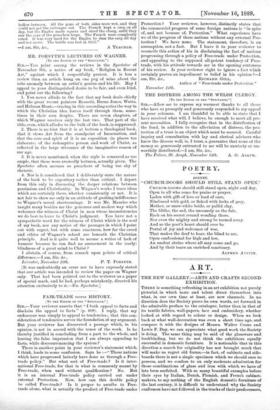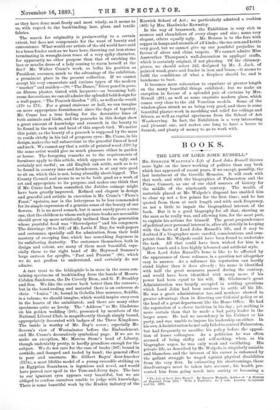ART.
THE NEW GALLERY.—ARTS AND CRAFTS SECOND. EXHIBITION.
THERE is something refreshing in an art exhibition not purely pictorial, in which taste and talent direct themselves into. what, in our own time at least, are new channels. In no direction does the Society prove its own words, set forward in_ the admirable preface to the catalogue, better than in that of its textile fabrics, wall-papers, lace and embroidery, whether looked at with regard to colour or design. When we look back at what wall-decoration was even a short time ago, and. compare it with the designs of Messrs. Walter Crane and Lewis F. Day, we can appreciate what good work the Society is doing. The same thing may be said of the glassware and. bookbinding, but we do not think the exhibitors equally successful in domestic furniture. It is noticeable that in this direction a search for originality has not brought much that will make us regret old forms,—in fact, of cabinets and side- boards there is not a single specimen which we should cars to. possess, and we confess to an only moderate admiration for those combinations of glass and iron with which we have of late been surfeited. With so many beautiful examples before their eyes by Italian, Dutch, Flemish, and French cabinet- makers, to say nothing of the English domestic furniture of the last century, it is difficult to understand why the Society craftsmen have not followed in the tracks of their predecessors,
as they have done most freely and most wisely, as it seems to us, with regard to the bookbinding, lace, glass, and textile fabrics.
The search for originality is praiseworthy to a certain extent, but does not compensate for the want of beauty and convenience. What would our artists of the old world have said to a brass fender such as we have here, throwing out iron stems terminating in wrought-iron roses of a very spiky character, for apparently no other purpose than that of catching the lace or muslin dress of a lady coming to warm herself at the fire ? Mr. Walter Crane's work, as befits his position as President, assumes, much to the advantage of the exhibition, a prominent place in the present collection. If we cannot accept his very emasculate and curious types of the modern " masher" and maiden—(90, "The Dance," frieze panel in gesso, on fibrous plaster, tinted with lacquers)—as becoming ball- room decorations, we can all admire the splendid bold design for a wall-paper, "The Peacock Garden" (91), as well as the result (170 to 173). For a grand staircase or hall, we can imagine on more appropriate furnishment since the days of tapestry. Mr. Crane has a true feeling for the decorative lines of both animals and birds, and the peacocks in this design show a great amount of knowledge and research in the beauty to be found in the neck and head of this superb bird. We notice this point, as the beauty of a peacock is supposed by the mass to reside chiefly in his tail of gorgeous eyes : Mr. Crane, in his design, makes the tail subservient to the graceful lines of head and neck. We cannot say that a settle of painted wood (110) by the same artist would give us much pleasure either in garden or house. The foregoing remarks as to the requirements of furniture apply to this article, which appears to us ugly, and certainly not useful ; an old English oak settle, such as is to be found in country inns and farmhouses, is at any rate good to sit on, which this is not, being absurdly short-legged. The County Council seal seems to us to be both good as a work of art and appropriate to its purpose, and makes one think that if Mr. Crane had been consulted, the Jubilee coinage might have been greatly improved. Refined and elegant in design and graceful and artistic in execution is Mr. Crane's "Flora's Feast," upstairs, nor is the letterpress to be less commended for its simple expression of a genuine sense of the beauty of our flowers. It is no novel remark, but it must surely prove a true one, that the children to whom such picture-books are accessible should grow up more artistically inclined than the generation whose youthful food was " Strewelpeter " and his congeners. The drawings (98 to 101) of Mr. Lewis F. Day, for wall-papers and cretonnes, specially call for admiration, from their bold mastery of sweeping line, which has something Japanese in its unfaltering dexterity. The cretonnes themselves, both in design and colour, are many of them most beautiful, espe- cially those to the right hand of Mr. Heywood Sumner's large cartoon for sgrajfito, "Past and Present" (66), which we do not profess to understand, and certainly do not admire.
A rare treat to the bibliophile is in store in the cases con- taining specimens of bookbinding from the hands of Messrs. Cobden. Sanderson, the Be Coverly Bros., and G. F. Stoakley and Son. We like the convex back better than the concave ; but in the hand-tooling and material there is an embarras de choir. "Ionica" (4), bound in Gobelin blue morocco, flexible, is a volume, we should imagine, which would inspire envy even in the hearts of the uninitiated ; and there are many other specimens quite as lovely. The " Address " to Mr. Gladstone on his golden wedding (105), presented by members of the National Liberal Club, is magnificently though simply bound, appropriately decorated with badges of the Three Kingdoms. The inside is worthy of Mr. Day's cover ; especially Mr. Severn's view of Westminster before the Embankment, and Mr. Crane's decoratively symbolical page. If we are to make an exception, Mr. Marcus Stone's head of Liberty, though undeniably pretty, is hardly grandiose enough for the subject. We do not care for the case of books (107) bound in cowhide, and damped and tooled by hand; the general effect is poor and nnornate. Mr. Gilbert Bayes' door-knocker
(117D), a most lifelike model of a young crocodile striking on an Egyptian Scarabtens, is ingenious and novel, and would have proved rare spoil in the Tom-and-Jerry days. The lace to our ignorant eyes appears very beautiful, but we are obliged to confess ourselves unable to judge with knowledge. There is some beautiful work by the Ruskin industry of the Keswick School of Art ; we particularly admired a cushion (465) by Mrs. Hardwicke Rawnsley.
In the way of brasswork, the Exhibition is very rich in sconces and chandeliers of every shape and size ; some very elegant, others equally ugly. Mr. Benson is to the fore with copper in lamps and utensils of all kinds; the tea-urn and kettle very good, but we cannot give up our youthful prejudice in favour of silver and china teapots. We cannot admire Miss Anstruther Thompson's wall-decoration in appliqué stuffs, which is certainly original, if not pleasing. Of the chimney- pieces, we should select 242, designed by Mr. J. Jack, of painted wood, grate and fender in iron and brass,—it seems to fulfil the conditions of what a fireplace should be, and is handsome to boot.
It becomes mere reiteration to expatiate at greater length on the many beautiful things exhibited ; but we make an exception in favour of a splendid pair of curtains by Mrs. Newall (281), as well as some exquisite modern glass, which comes very close to the old Venetian models. Some of the window-glass struck us as being very good, and there is some beautiful plaster-work in moulding and relief for ceilings and friezes, as well as capital specimens from the School of Art Woodcarving. In fact, the Exhibition is a very interesting and pleasant one, and makes one long to have a house to furnish, and plenty of money to go to work with.



















































 Previous page
Previous page